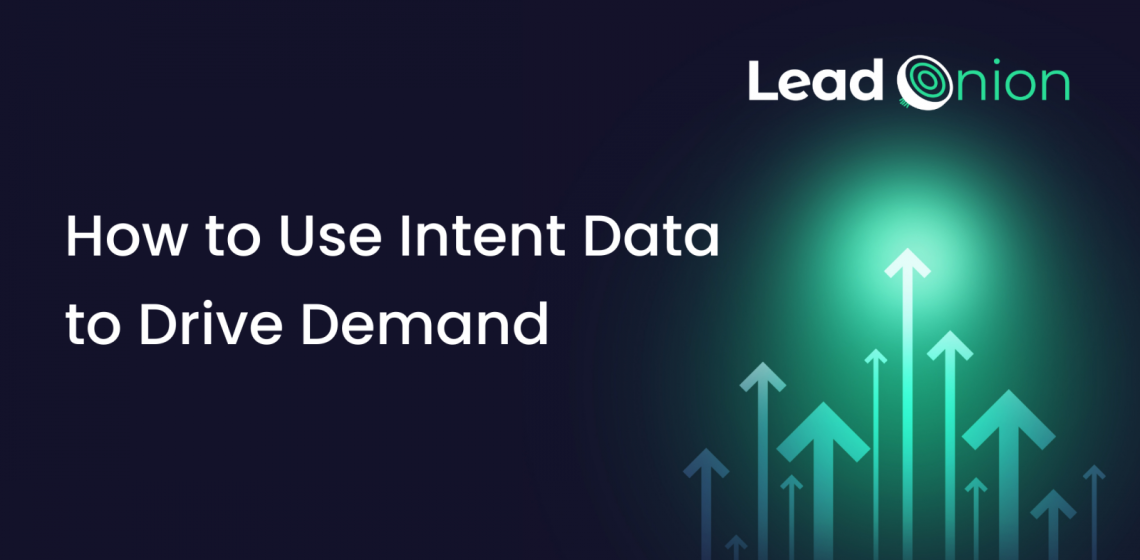The impact of data on-demand generation has increased significantly over the past 5 years.
94% of marketers surveyed by Ascend2 said that the performance of a demand generation programme is improved by a Data-Driven Strategy.
Savvy Marketers are now making data a pivotal part of their overall Marketing Strategy.
But not all data is created equally. Many companies start with the wrong data and spend endless marketing dollars on stale, outdated and irrelevant data. In 2022, Marketers are making the shift towards an intent-driven approach to demand generation.
In our previous blog; The Truths and Myths of B2B Intent Data we delved deeper into what exactly is Intent Data, the different forms (1st, 2nd and 3rd Party Intent) and what makes a good intent signal.
Now, we will look at how Intent Data can be used to drive demand and some of the challenges with a data driven approach.
Demand Generation is a multi-channel process involving a range of interactions and many data points. Being able to adequately track performance of a demand generation campaign is vital to ensure successful outcomes. However, one of the biggest challenges faced by Marketers today is the ability to make data actionable within their demand generation programme.
We see that at each layer of Intent from 1st Party (e.g. website visits) to 2nd Party (e.g. G2 category page views) and 3rd Party (e.g. engagement with a particular topic) the data changes by its nature. Therefore, making it actionable can be a frustration for many Marketers.
How to make Intent Data Actionable and Drive Demand?
- Identify your Ideal Customer Profile.
- Leverage workflows and the power of automation.
- Target the full buying committee.
- Use personalisation and serve the right message at the right time.
- Learn from your success and target lookalike audiences.
Identifying Your Ideal Customer Profile
What does my ideal customer look like? That’s the question that many Marketers fail to address at the outset of their demand generation campaign.
Too often we focus on lead generation at all costs and don’t focus on the ideal customer profile. This leads to wasted marketing dollars, efforts and strained relations between sales and marketing.
When it comes to an Intent-Driven approach to demand generation, we can leverage the Intent Data at our fingertips to help mould our ideal customer profile.
Traditionally an ideal customer profile would consist of company and persona filters. However, we can layer in Intent Signals to ensure that the customers we do engage with are showing intent and are ready to buy.
For example, we might want to target Computer Software Companies in the USA with a revenue range of $1m+ and we may identify the buying committee for our product to consist of Heads of Marketing and Sales.
Now, we can go and purchase static email lists and run email marketing campaigns to attempt to engage our audience but what if we layer in some intent parameters. E.g. we have 1 or 2 major competitors that we know we can take business from, what if we find companies in our target range who are engaging with those competitors, and in real time?
Another example is we could track a topic that is aligned very closely with our product.

When we see an increase in consumption of articles by our target audience then we can add that company to our target audience. So, layering in intent data means you can narrow in on those companies that not only meet your traditional ICP, but who are showing buying signals.
Did you know Lead Onion has 17 different sources of Intent Data which can be leveraged to build out your target audience.
Leverage Workflows and the Power of Automation
One of the biggest challenges for any high-volume data strategy is how to reduce the need for manual processes. Workflow Automation involves the systematic automation of business processes, and we can leverage it in the context of Intent Data for sales and marketing by automatically directing data to the right place and for the right purposes.
When you are working with Intent Data the volume of target accounts can become too much to handle manually for sales and marketing so it’s vital to use workflows to direct data to the right stage of your marketing funnel.
For example, a company showing 1st Party Intent e.g. a visit to your website would require a different approach to a company showing intent by consuming a lot of content around a topic related to your business, one is aware of your brand and further down the funnel than the other. We can use workflows and automation to send these accounts to the correct stage and out to the right channels.

Target the Full Buying Committee
According to Gartner “The typical buying group for a complex B2B solution involves six to 10 decision makers, each armed with four or five pieces of information they have gathered independently”.
This generally means that Marketers have a wide range of people and personalities to influence when pitching your B2B solution to a customer.
You will likely need to influence different people at different stages of the process also, from the identification of a problem to solution exploration and finally selection and validation.
So, it’s never been more critical to ensure you are targeting the full buying committee when it comes to marketing B2B solutions.
Typically, Marketers focus on their one ideal buying persona mainly due to the costs of and difficulty in acquiring data for the buying committee. A lot of Intent Data providers only provide company level intent and this needs to be supplemented with decision-makers data to ensure that marketing can reach out. That comes at a cost and adds complexity to the process.
With tools like Lead Onion, our customers can target the full buying committee as we provide compliant B2B contact information for everyone in the organisation, at the click of a button, you can reveal and market to all of the influencers in an account that is showing intent.
Not only that, you can ensure you serve the appropriate message to the appropriate person in the buying committee to overcome differing priorities e.g. you may focus on value for money or ROI when targeting the CFO but you may focus on useability, features & benefits when targeting a primary user.
Use Personalisation and Serve the Right Message at the Right Time
Intent Data can be an excellent source of data for your personalised outreach. As Marketers we all know the importance of personalisation for user experience. So how does Intent Data feed into that?
Simply, you use the source of the intent to create engaging content relevant to their activity or their business.
Best explained via an example; Say you are targeting High Growth Marketing Agencies with your product, and your target buyer is the Chief Operating Officer. Now, say you see from Lead Onion’s intent platform that a company within your ICP has just recently received a Series A investment round, that’s a good sign indicating high growth, excellent.
Now, in your outreach if you were to congratulate the COO on their successful funding round that is going to set you apart from other vendors and is a good way to open the conversation.
Learn from your Success and Target Lookalike Audiences
Lookalike audiences are common practice when it comes to using ad networks. However, they only go as far as demographics or firmographics. What if you could use Intent Data to find companies who are on a similar buying journey to companies you have successfully sold to in the past? Wouldn’t that be a powerful addition to your toolkit?

Lead Onion is the only intent platform on the market that allows you to loop back into your marketing process the intent signals that lead to success so that you can find companies who meet the same firmographics as your customer base but also are showing similar intent signals to those companies you have successfully sold to in the past.
The system becomes a self-fulling engine and continuously learns what works best for your business, providing you with a bespoke lookalike audience that has a much higher chance of converting. Powerful!
In conclusion, Intent Data is an extremely powerful tool for helping B2B companies to drive demand and take their marketing programmes to the next level. Marketers know that Intent Data is the future and you don't want to be left behind if you are not implementing it into your strategy for 2022.
Want to learn more? Have a look at our platform in action here, or book a demo to see it in real time!



